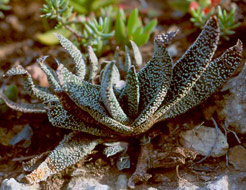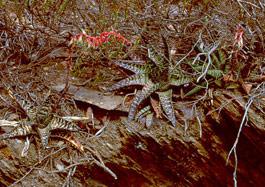Gasteria carinata
Gasteria carinata (Mill.) Duval
Family: Asphodelaceae
Common names: Keeled ox-tongue, Bredasdorp gasteria (Eng.); Bredasdorp-beestong (Afr.)
Introduction
Gasteria carinata is a small to medium-sized aloe-like plant bearing triangular, mottled, channelled leaves and racemes of pinkish flowers during spring. It is endemic to the eastern part of the Western Cape, growing in dry fynbos vegetation. It thrives in cultivation and is easily grown from leaf cuttings or seed.

Description
Description
Plants stemless, decumbent to ascending 30-180 mm tall, proliferating from the base to form small dense groups 150-600 (800) mm in diameter. Roots succulent, up to 6 mm in diameter. Leaves opposite at first, becoming rosulate, spirally arranged or sometimes remaining distichous (arranged in two vertical rows on opposite sides of the stem), 30-120 (-180) mm long and 10-45 (-50) mm broad at the base, triangular to triangular-spear-shaped, rarely tongue-shaped, ascending, the lower leaves becoming spreading; upper surface plane or channelled, the lower with a distinct keel or sometimes rounded. Both surfaces with rough tubercles or smooth, sometimes almost like sandpaper. The leaves are spotted in obscure transverse bands; margin leathery, tuberculate, bearing small inconspicuous rounded teeth. The leaf end is sharp with a hard point. Juvenile leaves in two rows, ascending spreading, smooth or tuberculate, tongue-shaped (lorate); the tip rounded, ending in a hard sharp point (mucronate). Inflorescence a raceme 150-700 (900) mm tall, spreading and slightly curved, the floral bracts 6-12 mm long, 2,4 mm broad at the base. Pedicel (flower stalk) 7-15 mm long. The flowers (perianth) are variable, 16-27 mm long, swollen at the base by more than half of the flower length, thence constricted to a tube 3-5 mm in diameter, the swollen portion (gasteriform) pink, 6-8 mm in diameter, the tube white with green stripes. Fruiting capsule 19-23 mm long, oblong, 7 mm broad. Seeds 3-4 mm long and 2 mm wide.
Flowering period: Winter to late Spring (July to November in the southern hemisphere) but with a peak in spring (September-October).
Gasteria carinata is related to G. nitida which has bright orange-pink flowers flowering during summer.
Distribution and habitat
Distribution description
Widely distributed in the southern Western Cape south of the Riviersonderend and Langeberg Mountains from Hermanus in the west to Mossel Bay in the east.
G. carinata is found from close to sea level up to approximately 300 m in altitude. The habitat consists of hilly terrain where the natural vegetation is Renosterveld (Western- and Central Ruens Shale Renosterveld) and occasionally Limestone Fynbos (Mucina & Rutherford 2006). It occurs mainly on shale and sandstone outcrops usually confined to the embankments of dry stream beds, often in shade of Carissa bispinosa. The rock formations consist mainly of shale (Bokkeveld Group, Cape Supergroup) and limestone of the Bredasdorp Formation. Near Mossel Bay plants grow quite close to the sea. Rainfall of 300-500 mm occurs in winter and summer but with a tendency to summer dryness. Summers are hot, with cool nights. Winters are moderate, and if frost occurs, it is slight. The plants grow in small dense groups, almost always in the protection of herbs and shrubs and are well camouflaged and difficult to locate. Occasionally plants may be found in the open. The vegetation is sclerophyllous (with hard, leathery leaves), the plant community is open, up to 1 m tall, interspersed with taller shrubs.
Gasteria carinata is very variable in leaf shape, colour and texture. Three varieties are recognised: G. carinata var. carinata with leaves in a rosette and with a tuberculate surface. This variety is the most common and is confined to the western and southern portion of the distribution area of the species. G. carinata var. glabra grows towards the east and has smooth leaves. G. carinata var. verrucosa has densely grey-green leaves which remain opposite and have a densely tuberculate surface.



Gasteria carinata proliferates from stolons from the base of the stem forming small groups. The following cultivars have been named:
'Melkbos' - A large form with tuberculate leaves.
'Kykoedie' - A small form (introduced by Mr Bruce Bayer). It has short and broad triangular, tuberculate leaves 60 mm in length.
'Mossel Bay' - In the eastern part of the distribution range a beautiful, prolific plant was collected by Professor E. A. C. L. E. (Ted) Schelpe. The plants have smooth linear lorate leaves 90-120 mm x 15-20 mm with a blunt point and dense spotting in attractively arranged transverse bands.
'Great Brak' - From the Great Brak River a prolific clone was brought into cultivation at Stellenbosch University Botanic Garden which was later described as G. schweickerdtiana Poelln. The plants have smooth, tongue-shaped, very faintly spotted leaves, 70-100 mm x 20-25 mm, with a blunt point.
'Klein Brak' - From Kleinvlei near Klein Brak, introduced by Mr Howard Gie, a form with smooth, faintly spotted, triangular-spear-shaped leaves 80-110 mm x 40-45 mm.
Derivation of name and historical aspects
History
Gasteria carinata var. carinata and var. verrucosa, together with G. disticha were the earliest succulents from the Cape to have reached Europe. G. carinata var. verrucosa was first described by Oldenland under the phrase name "Aloe africana flore rubro folio triangulari et verrucoso ab utraque parte albicanti notato" in his "Kruid boek", or Herbarium of South African plants, made at the Cape probably between 1688-1697.
According to Commelin the plant was cultivated in the Amsterdam Medicyn Hof, from seed received from Africa. It is probable that the seed was collected south of the Langeberg by Oldenland when he accompanied Schrijver on his expedition in 1689.
The specific epithet 'carinata' is derived from Latin (meaning a keel) and pertains to its keeled leaves.
Uses
Use
Apart from their horticultural use, the plants are not used medicinally or otherwise.

Growing Gasteria carinata
Grow
Gasteria carinata has been well established in cultivation (ex situ preservation) and is grown by succulent plant enthusiasts all over the world. It does best as a pot plant or on rockeries in dry fynbos gardens. It also grows well in Mediterranean gardens where frost is not too severe. It is a slow grower, but when grown from cuttings it can flower within 3 years. Plants prefer partial shade, and in hot climates should therefore be protected from full sun.
Propagation
Easily propagated from seed, division or leaf cuttings. It is best to apply a fungicide when growing it from seed. Sow seed during spring or summer in a warm, shady position in a sandy, slightly acidic soil and keep moist. Cover with a thin layer of sand and keep moist. Germination is usually within 3 weeks. Seedlings grow slowly and are best planted out about a year after sowing. Propagation from leaf cuttings is best undertaken in spring. Allow the leaf cuttings to form a heel by placing them on a dry window sill for a week or three. Cuttings are best rooted in clean sand. Once rooted, plants can be planted into individual containers. Plants react well to organic feeding (compost or any other liquid fertilizer). Gasteria carinata is best watered throughout the year, but sparingly in winter.
References
- Mucina, L. & Rutherford, M.C. (eds) 2006. The vegetation of South Africa, Lesotho and Swaziland. Strelitzia 19. South African National Biodiversity Institute, Pretoria.
- Van Jaarsveld, E.J. 1994. Gasterias of South Africa. Fernwood Press.
- Van Jaarsveld, E.J. 2007. The genus Gasteria, a synoptic review. Aloe 44: 4: 84-103.
Credits
Ernst van Jaarsveld
Kirstenbosch National Botanical Garden
April 2012
Plant Attributes:
Plant Type: Succulent
SA Distribution: Western Cape
Soil type: Sandy, Loam
Flowering season: Spring, Winter
PH: Acid, Neutral
Flower colour: Pink
Aspect: Full Sun, Shade, Morning Sun (Semi Shade)
Gardening skill: Easy
Special Features:
Horticultural zones









Rate this article
Article well written and informative
Rate this plant
Is this an interesting plant?
Login to add your Comment
Back to topNot registered yet? Click here to register.